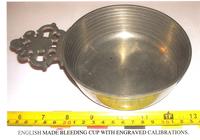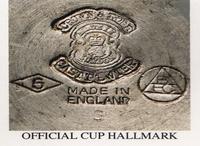
South Australian Medical Heritage Society Inc
Website for the Virtual Museum
Home
Coming meetings
Past meetings
About the Society
Main Galleries
Medicine
Surgery
Anaesthesia
X-rays
Hospitals,other organisations
Individuals of note
Small Galleries
Ethnic medicine
- Aboriginal
- Chinese
- Mediterran
Blood letting, scarificators and bleeding cups
ACKNOWLEDGEMENTS
We were very happy to be able to photograph two interesting items of medical heritage.
Mr. Mervyn Smith OAM and past president of the Royal Australasian College of Surgeons
kindly provided the bleeding cup, and Dr. J. P. Couper-Smartt gave us a temporary loan of the
scarificator and the suction cup.
We also know that another scarificator can be found in the museum of the Willows winery in
the Barossa valley.
Blood letting was a common form of treatment used for a series of diseases, and records exist
in the earliest medical literature from Egypt, India (Ayurvedic texts) and other civilizations.
The treatment must have been successful in many cases and was not abandoned until late
18th century.
There are some patients with polycythemia (increased red cell numbers) and similar diseases
who still benefit.
The old belief was that removal of some body fluids such as blood, urine or gastric contents was beneficial. This was certainly so with collections of pus, pleural or other joint effusions. The practice was supported by many public figures, and King Charles II and George Washington had blood lettings. In the case of the latter, this may have contributed to his death, after being bled of 124-126 ounces (approximately 3.7 L), over half of his blood, over a 9 - 10 hour period.
Some reasons for its persistent popularity may be a possible placebo effect, and it could have had some benefit in hypertension.
Blood letting methods
Phlebotomy (cutting a moderate size vein) was common and there are several diagrams to
indicate various sites. The cubital vein in the elbow was common. Arterial puncture was
used occasionally, but the most common site was the skin, and various types of lacerations
(caused by a scarificator) were used. Quite often negative pressure, provided by
moxibustion or rubber bulbs, was used to increase the blood loss.
Special cups were used to monitor the blood loss, usually a fraction of the blood volume.
John Couper-Smartt's scourier or scarificator. Manufactured by J. P. Wood in Manchester made of brass and steel. The size is 6x4x6 cm. It contained nine cutting blades nearly four millimetres deep.
The picture shows the scarificator (bottom right), and a rubber cup used to produce a partial vacuum and increase the bleeding. Another method which was used was moxibustion, in which powdered moxa (from the Japanese mogusa, where the "u" is almost silent), also known as mugwort (Atemisia argyi, a type of wormwood), is burned. Similar effect could be achieved by burning cotton wool soaked in methylated spirits in a glass. When the burning ceased, the mouth of the glass was placed on the skin, and as the air cools it contracts, producing a negative (relative) pressure. This increased blood loss. It is also used in cupping, a common practice used even now in China and South-East Asia. Notable Western users of cupping include Gwyneth Paltrow and Jennifer Aniston.
The amount of blood drained by the above methods was most important. The usual human blood volume is cited as five to six litres, or around 77 mL/kg. Thus, it is most important not to remove too much and induce hypotension and shock. Several containers with measuring scales were available.
The bleeding cup and its seven markings have been kindly provided by Mr. Mervyn Smith. It was given to him as a present from the Royal Surgical College of England as a present to the president of the Australian Branch (RACS).
Each concentric ring on the interior surface of the cup denotes a two ounce increment, therefore this cup can hold 16 UK fluid ounces (~ 455 mL) of blood.



